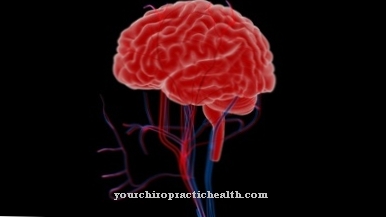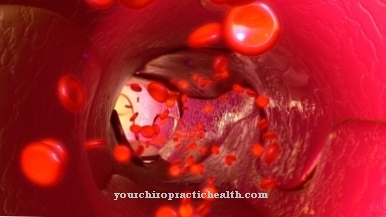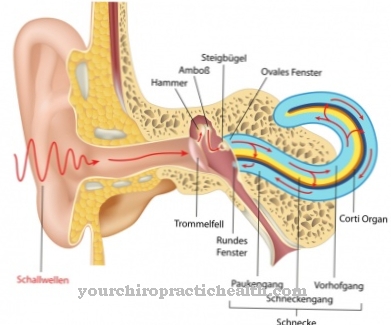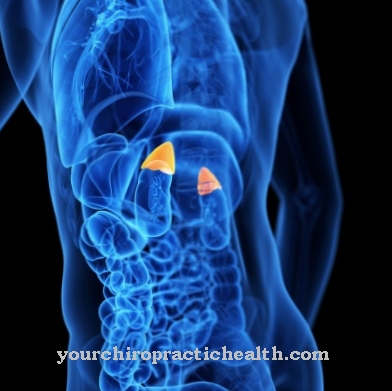Of the Body circulation is also known as great blood circulation designated. It directs the blood through most of the body. The other important circuit in the body is the pulmonary circulation, which carries blood to and from the lungs.
What is the bloodstream?

The body's circulation begins in the left ventricle. With the contraction of the ventricular musculature, the oxygen-rich blood is expelled through the aortic valve into the aorta. 80 milliliters of blood reach the main artery with each heartbeat. The amount of blood ejected is also known as the stroke volume.
The aorta arises directly from the heart. With a diameter of around three centimeters and a length of around forty centimeters, it is the largest artery in the human body. Their shape resembles a walking stick. The arched beginning runs over the heart, then the vessel runs down to the pelvis. According to its shape, the aorta is divided into an ascending aorta, the aortic arch, and a descending aorta. The descending aorta can in turn be divided into thoracic and abdominal aorta.
All other large arterial vessels branch off from the main artery. The most important branches include the brachiocephalic trunk, the common carotid artery, the subclavian artery, the celiac trunk, the superior mesenteric artery, the inferior mesenteric artery and the common iliac artery. These large arteries divide into smaller and smaller arteries.
The arteries then branch into arterioles. Arterioles are small arteries. They are the finest blood vessels that can still be seen with the naked eye. The capillaries follow the arterioles. They are only 0.5 millimeters long and have a maximum vessel diameter of 10 micrometers. They form a fine capillary network in the organs and tissues, which is supplied with blood by the arterioles.
The capillaries merge into venules. The oxygen-poor blood from the organs and tissues collects in these. The venules unite to form larger veins. Some veins have portal veins interposed. The best known and most important portal vein is the portal vein of the liver (Vena portae). It collects the entire blood of the unpaired abdominal organs. Ultimately, all of the body's veins go into the upper (superior vena cava) or lower (inferior vena cava) vena cava. These two large veins carry the venous blood back to the heart. They flow into the atrium of the right heart.
From there, the blood reaches the lungs via the small circulation system and finally to the left atrium. Then the great cycle begins again.
Function & task
The main task of the body's circulation is to supply the organs and body tissues with oxygen-rich blood and to dispose of the venous blood. The large arteries are under high pressure and flow speed. The blood is quickly distributed throughout the body.
The arterioles serve as control valves. If the blood would flow into the small capillaries with the pressure of the large arteries, this would lead to vessel and tissue damage. Arterioles have very strong muscular walls. By closing (vasoconstriction) or opening (vasodilation) they can control the flow of blood.
The small capillaries are used to exchange fluids, electrolytes, vitamins, nutrients, hormones and other substances. The capillaries are equipped with a thin vessel wall for this function. This membrane is permeable to small-molecule substances, so that all necessary nutrients can get into the tissue.
In some organs the capillaries are dilated. Such sinusoids are found, for example, in the liver and spleen. The surface of the sinusoids also allows larger molecules to cross over. In the liver, for example, proteins are synthesized that have to pass through the sinusoids. Red blood cells leak in the spleen. The spleen is used, among other things, to sort out obsolete or deformed blood cells.
Like the capillaries, the venules only have a very thin vessel wall.They collect the venous blood from the tissue and deliver it to the veins. They also serve to remove waste and metabolic end products. The veins have thin but muscular walls. They also serve as a blood reservoir for the body.
Another important task of the body's circulation is thermoregulation. The blood supply to the skin is controlled via the vessels. This also regulates the heat dissipation via the body surface and ultimately the body temperature.
Illnesses & ailments
Circulatory disorders can affect the heart or blood vessels. The most common cardiovascular disease is high blood pressure. Too high blood pressure damages the heart and blood vessels in the long term. The high pressure can cause small cracks in the inner skin of the vessels. At these points, the vessel walls thicken and harden for stabilization: Atherosclerosis develops.
Other risk factors for the development of vascular calcification are lack of exercise, obesity, smoking, gout, diabetes mellitus or high cholesterol levels (hypercholesterolemia). Secondary diseases of atherosclerosis are heart attacks or strokes. Peripheral arterial occlusive disease (PAOD) and renal insufficiency are also possible consequences of vascular calcification.
The aortic aneurysm is a life-threatening circulatory disease. It is a bulging of the aorta. With a pronounced aneurysm, there is a risk of the tear. Such a rupture is associated with a very high mortality rate. The affected patients bleed to death internally within a few minutes. What is particularly tricky is that most aneurysms do not cause discomfort before rupture.













.jpg)

.jpg)
.jpg)











.jpg)